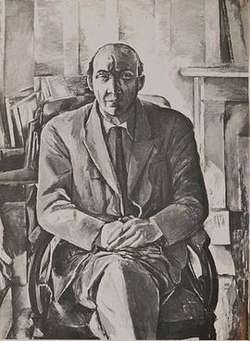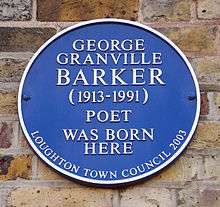George Barker (poet)
George Granville Barker (26 February 1913 – 27 October 1991) was an English poet, identified with the New Apocalyptics movement, which reacted against 1930s realism with mythical and surrealistic themes. His long liaison with Elizabeth Smart was the subject of her cult-novel By Grand Central Station I Sat Down and Wept.
George Barker | |
|---|---|
 George Barker, by Patrick Swift, c. 1960 | |
| Born | 26 February 1913 Loughton, Essex, England |
| Died | 27 October 1991 (aged 78) Itteringham, Norfolk, England |
| Occupation | Poet |
| Nationality | English |
| Education | Regent Street Polytechnic |
Life and work
Barker was born in Loughton, near Epping Forest in Essex, England, to English father George Barker (1879–1965), a temporary police constable and former batman in the Coldstream Guards (during World War I, when he returned to the regiment, he earned a field commission to the rank of Major) who later worked as a butler at Gray's Inn,[1][2] and Irish mother Marion Frances (1881–1953), née Taaffe, from Mornington, County Meath, near Drogheda, Ireland; they moved to Chelsea when Barker was six months old.[3][4][5][6] His younger brother was the painter Kit Barker; they were raised at Battersea, London, and the family later lived at Upper Addison Gardens, Holland Park.[7]
Barker was educated at an L.C.C. school and at Regent Street Polytechnic. Having left school at an early age he pursued several odd jobs before settling on a career in writing. Early volumes of note by Barker include Thirty Preliminary Poems (1933), Poems (1935) and Calamiterror (1937), which was inspired by the Spanish Civil War,[8] and contains an attack on the Spanish Nationalists.[9]
In his early twenties, Barker had already been published by T. S. Eliot at Faber and Faber, who also helped him to gain appointment as Professor of English Literature in 1939 at Tohoku University (Sendai, Miyagi, Japan). He left there in 1940 due to the hostilities, but wrote Pacific Sonnets during his tenure.
He then travelled to the United States where he began his longtime liaison with writer Elizabeth Smart, by whom he had four of his fifteen children. Barker also had three children by his first wife, Jessica.[10] He returned to England in 1943. From the late 1960s until his death, he lived in Itteringham, Norfolk, with his wife Elspeth Barker, the novelist. In 1969, he published the poem At Thurgarton Church, the village of Thurgarton being a few miles from Itteringham.
Barker's 1950 novel, The Dead Seagull, described his affair with Smart, whose 1945 novel By Grand Central Station I Sat Down and Wept was also about the affair.[11] His Collected Poems (ISBN 0-571-13972-8) were edited by Robert Fraser and published in 1987 by Faber and Faber. Barker was partly associated with the New Apocalyptics movement,[12] which reacted against 1930s realism with surrealistic and mythical themes. But his characteristically independent idiosyncrasies set him off as an individual in his own right.[13]
A notoriously uneven writer, Barker's masterpiece was considered by C. H. Sisson to be The True Confession of George Barker.[14]
In describing the difficulties in writing his biography, Barker was quoted as saying, "I've stirred the facts around too much ... It simply can't be done." However, Robert Fraser produced a biography, The Chameleon Poet: A Life of George Barker, in 2001.[15]
Bibliography

- Selected Poems, edited by Robert Fraser, Faber and Faber (1995)
- The Chameleon Poet: A Life of George Barker, Robert Fraser, Jonathan Cape Ltd (2002)
- Poems by George Barker, selected by Elspeth Barker, Greville Press (2004)
- Selected Poems, New York : Macmillan Co (1941)
- Homage to George Barker on his sixtieth birthday, edited by John Heath-Stubbs and Martin Green, Martin Brian & O'Keeffe (1973)
- Dibby Dubby Dhu and other poems, illustrated by Sara Fanelli, Faber (1997)
- Poems of places and people, Faber and Faber (1971)
- Collected Poems, 1930–1955. Faber & Faber (1957)
- Thirty Preliminary Poems, David Archer (1933)
- Street ballads, Faber & Faber (1992)
- The alphabetical zoo, Illustrated by Krystyna Roland, Faber and Faber (1972)
- A vision of beasts and gods, Faber (1954)
- The view from a blind I, Faber (1962)
- Eros in Dogma, Faber & Faber (1944)
- The True Confession of George Barker, MacGibbon & Kee (1965)
- Calamiterror, Faber & Faber (1937)
- Janus(The Documents of a Death.-The Bacchant.) [Two tales.], Faber & Faber (1935)
- At Thurgarton Church, A poem with drawings, etc., London : Trigram Press (1969).
- The Dead Seagull, Farrar, Straus & Young New York (1951)
- Love Poems, New York : Dial Press (1947)
- Dreams of a summer night, Faber & Faber (1966)
- News of the world, Faber (1950)
- III hallucination poems, New York City : Helikon Press (1972)
- Alanna Autumnal, London : Wishart (1933)
- Two plays, Faber (1958)
- Poems, Faber & Faber (1935)
- Elegy on Spain, Manchester : Contemporary Bookshop (1939)
- Lament and Triumph, Faber & Faber (1940)
- The golden chains, Faber (1968)
- Runes and Rhymes, Tunes and Chimes, illustrated by George Adamson, Faber & Faber (1969)
- To Aylsham Fair, illustrated by George Adamson, Faber & Faber (1970)
- Essays, MacGibbon & Kee (1970)
- Dialogues etc., Faber (1976)
- Seven poems, Greville Press (1977)
References
- The Chameleon Poet: A Life of George Barker, Robert Fraser, Jonathan Cape, 2001
- https://www.theguardian.com/books/2002/mar/02/biography.highereducation
- George Barker, Martha Fodaski, Twayne Publishers, 1969, p. 13
- https://www.oxforddnb.com/view/10.1093/ref:odnb/9780198614128.001.0001/odnb-9780198614128-e-49571
- https://www.independent.ie/woman/celeb-news/the-cold-heart-of-passions-thief-26239284.html
- Encyclopaedia of British Writers, From 1800 to the Present, second edition, 20th Century and Beyond, ed. George Stade et al, DWJ Books LLC, 2009, p. 35
- Rough Draft: The Modernist Diaries of Emily Holmes Coleman, 1929-1937, ed. Elizabeth Podnieks, University of Delaware Press, 2012, p. 252
- D. Daiches ed., The Penguin Companion to Literature Vol 1 (1971) p. 34
- Stanley Weintraub, The Last great cause. The intellectuals and the Spanish civil war. London : W. H. Allen, 1968. (pp. 79-80)
- Sansom, Ian (March 2, 2002). "Master of the red Martini". The Guardian. Retrieved 2008-07-08.
Jessica has just given birth to his twins, Elizabeth Smart is busy giving birth to her second child by him, and he is spending most of his time drinking in London.
- I Ousby ed., The Cambridge Guide to Literature in English (1995) p. 38
- I Ousby ed., The Cambridge Guide to Literature in English (1995) p. 38
- C. H. Sisson, English Poetry 1900-1950 (1981) p. 243
- C. H. Sisson, English Poetry 1900-1950 (1981) p. 248
- The Chameleon Poet: A Life of George Barker (Jonathan Cape Ltd, 2002, ISBN 978-0-7123-0540-2).
Further reading
- Daniel Farson, Soho in the Fifties (Michael Joseph, London, 1987).
- An Anthology from X (Oxford University Press, 1988)
- Patrick Swift 1927-83 (Gandon Editions, Kinsale, 1993).
- Selected Poems, HOMAGE TO GEORGE BARKER (On his Sixtieth Birthday). John Heath-Stubbs & Martin Green, eds, 1973. Includes portrait of Barker by Swift seen here.
- The Chameleon Poet: A Life of George Barker, Jonathan Cape Ltd (21 Feb 2002), ISBN 978-0-224-06242-8
- The Spoken Word: George Barker [Audiobook], ISBN 978-0-7123-0540-2
- Barker, Christopher, The Arms of the Infinite: Elizabeth Smart and George Barker" (Wilfrid Laurier University Press, 2010) ISBN 978-1554582709
External links
| Wikiquote has quotations related to: George Barker (poet) |
- Essay by Robert Fraser, Open University
- Short informal biography with links to some of Barker's poems
- Barker's Grave
- More links to Barker's poems
- "Archival material relating to George Barker". UK National Archives.

- A large collection of Barker's papers is located at the Harry Ransom Humanities Research Center at The University of Texas at Austin.
- George Barker collection at University of Victoria, Special Collections
- George Barker Collection, 1930-1966 at Southern Illinois University Carbondale, Special Collections Research Center.
- Truly, madly, deeply - Peter Wilby, The Guardian, 2008
- Master of the red Martini - Ian Sansom, Guardian
- Bohemians - The European Graduate School
- Paul Potts on ‘The World of George Barker’
- George Barker - Richard Poole
- Archival Material at Leeds University Library
- Papers of George Barker at the British Library with links to other Barker collections
- George Barker papers at the University of Maryland Libraries